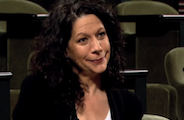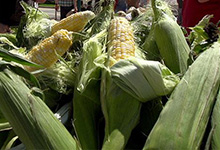
Scientific Discipline
Developmental Biology, Genetics
Related Links
Host Institution
Carnegie Institution of Washington
Current Position
Dr. Spradling is also director of the Department of Embryology at the Carnegie Institution of Washington, Baltimore; adjunct professor of biology at the Johns Hopkins University; and adjunct professor of molecular biology and genetics at the Johns Hopkins University School of Medicine.
Current Research
Laying the Egg's Foundation
Biography
One of the most fundamental questions humans ask is "Where do we come from?" For more than 30 years, Allan Spradling has been trying to answer that question by studying how eggs form and mature in the female fruit fly.
Such an approach may seem far removed from humans. But for the past one hundred years, research on Drosophila has revealed insights about heredity, chromosomes, gene expression, embryo development, behavior, and disease—in insects and higher organisms.
Spradling calls the fly "a little human with wings." Approximately 61 percent of human disease genes have a match in the fruit fly genome, and half of the insect's proteins have analogs in mammals. In fact, the 1995 Nobel Prize in Physiology or Medicine was given to scientists who discovered genes that form the fruit fly body plan—work that also applies to human development.
In his career, Spradling has elucidated key steps in egg development and, in collaboration with other scientists, including Gerald Rubin (Vice President and Director, Janelia Farm Research Campus, Howard Hughes Medical Institute), developed novel techniques that have revolutionized fly genetics, leading to the sequencing of the insect's genome in 2000.
Fruit flies are convenient for scientists to study because they are small, easy to keep in large numbers, and their genetics are well characterized. Scientists can determine results from genetic crosses quickly because the time from fertilization to a mature adult fly is only 10 days.
Spradling became hooked on flies as an MIT graduate student in the 1970s. He had created a method to study the insects' gene expression, which was an important advance in fly research at the time. Genes "get expressed" as the molecule mRNA, which the cellular machinery turns into proteins, the enzymes and structural components of cells. To understand how genes respond to environmental conditions, such as temperature, chemicals, or hormones, scientists studied and still study parts of the gene that respond and the changes in the levels of mRNA.
Before routine cloning and sequencing back then, scientists were able to study gene expression in microbes, such as yeast and the bacterium E. coli. But researchers could do limited gene expression analyses in higher or multicellular organisms, except in cells or cell lines that expressed an enormous amount of a particular gene—for example, a red blood cell making massive hemoglobin mRNAs.
"Mine was a system in a higher organism in which you could change gene expression at will," Spradling said. First, he applied heat to fruit fly cells that had been grown in culture to determine the genes expressed in response to the stimulus. He extracted newly formed mRNAs from the cells and then used them to find regions on the fly's chromosomes where the gene activity originated. mRNA binds its corresponding gene because it has a complementary structure to one of the two chromosomal DNA strands.
Spradling became excited about applying his tool to other fruit fly cells. "I wanted to take RNA from any tissue in the Drosophila, label it, and throw it on the chromosome to see where it came from." In the late 1970s, as a postdoctoral fellow, he did so, identifying fly chromosome regions linked to egg shell proteins and, ultimately, cloning their genes.
He came to the Carnegie Institute in 1980, wanting to continue studying egg proteins and how their gene expression was regulated. But his method didn't allow him to do that, nor did other available approaches. So he and Rubin, also a fruit fly geneticist who was then at Carnegie, developed a technique that ultimately enabled researchers to study any gene and its control in any cell of the fruit fly.
They took a transposon, a naturally occurring piece of DNA that incorporates itself into the chromosome, and added to it a gene known as rosy, which is needed for normal eye color. They injected their construct into the egg cells of flies lacking the rosy gene, which have a brownish eye color. Two generations later, some of the progeny flies had normal eyes, and were found to have stably acquired a single new copy of the rosy gene that was regulated normally. Later, Spradling and Rubin helped direct the Drosophila genome project. They generated and assembled a library of variant flies of particular value for understanding what each gene does. He and Rubin won the 2003 George W. Beadle Medal of the Genetics Society of America for helping to make Drosophila one of the premier model organisms for genetic research.
In his laboratory today, Spradling continues studying molecular mechanisms underlying fly egg production. He has found many genes involved in the process, some of which are similar to those in higher organisms.
One research area focuses on stem cells (or progenitor cells) that generate the ova throughout the adult female fruit fly's life. He has shown that cells near the stem cells provide a niche to support the maturation of stem cells into eggs. Today, many scientists are trying to coax stem cells to form tissues such as blood, skin, or heart muscle, and Spradling's findings suggest that the cellular milieu where those cells mature is important.
He also studies how support cells near developing egg cells transfer organelles and other material to the egg, influencing the egg's ultimate viability. Spradling believes studying the method the fly uses to create eggs will lead to insights about human egg formation.
Spradling is as excited today about research as when he first started. What is different now, he said, is that new technology makes it a little easier to get answers to the questions about life that still inspire wonder in us.
Articles & News
Research Papers
Selected Research Papers




